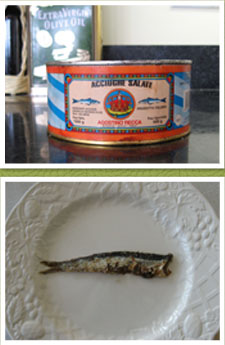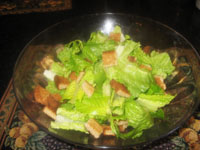This is for the millions of people around the world who hate anchovies. I want to introduce them to the 250 people who love them and like to eat them right out of the can. Yes, even though they have been salted down and eaten for thousands of years it is amazing that the knee-jerk negative reaction to anchovies is still so prevalent, especially among folks who never tasted them. I now know why. It’s because anchovies are actually a health food and only health food fans receive them with joy. All others, innocent and unknowing, remain suspicious.
So to try to make a dent in the unwarranted negative attitude that emerges anytime a recipe calls for anchovy I offer a few factoids.
Number one, obviously anchovies are a fish, to be precise the official name of the type we find in the stores is engraulis encrasiculus. They are swimming around in huge numbers with about 140 other variations from sea to shining sea. A fish they are indeed and a very oily one at that, like salmon and mackerel. Consequently the cardiologists of the world should be encouraging their consumption aggressively since they contain inordinate amounts of omega-3 fatty acids – you know, the stuff that prevents heart attacks.
That explains why Sicilians, Portuguese, Greeks and other Southern Mediterranean populations have roughly half the rate of heart disease as the U.S. The anchovy, with the help of other piscatorial relatives is a benevolent contributing factor. (I know I’m going to be challenged on all this but I’m ready).
Number two. Anchovies are not “fishy.” If you think they’re fishy then you think tuna and lobster are fishy. In their natural state anchovies have no fishy flavor whatsoever as long as they’re fresh. The salting process is responsible for amplifying the natural flavor to a point where one might consider it fishy but the salt can be easily removed. Also during cooking a lot of the flavor they started out with in the can is toned down.
OK, as for the salt it requires little or no effort to remove this offending chemical from the picture. All it takes is a soaking in milk or water for 30 minutes or so. Even if you don’t remove the salt using anchovy in a recipe makes it unnecessary to add additional amounts since it might supply all you need. So the bottom line is if you can bring yourself around to regarding anchovies as a health food we are going to get along just fine.
In the U.S. probably the most predominant use of anchovies is in “classic” Caesar Salad. “Classic” in quotes because, don’t you know, anchovies were never a part of the original Caesar recipe developed by Chef Cesare Cardini way back when in Mexico. They found their way into the salad dressing recipe somewhat indirectly. Caesar’s brother and restaurant partner Al, to give the recipe his own fingerprint one supposes, brushed the croutons with chopped anchovy. In any event anchovies are now ensconced in the preparation and without them people have a right to claim they are not being served a genuine Caesar’s.
If you like really good Caesar salad you like anchovy. You just have to own up to it.
One other note:  Now and then on the cooking shows you find the chefs reaching for a can of dry-packed salted whole anchovies rather than the filets packed in oil and widely sold in the flat oval cans or small bottles. I used the dry-packed specimens myself for a while until I finally realized that washing off the salt and prepping them for use is so labor intensive it qualifies for inclusion in the Jobs Bill.
Now and then on the cooking shows you find the chefs reaching for a can of dry-packed salted whole anchovies rather than the filets packed in oil and widely sold in the flat oval cans or small bottles. I used the dry-packed specimens myself for a while until I finally realized that washing off the salt and prepping them for use is so labor intensive it qualifies for inclusion in the Jobs Bill.
The fish are packed whole with only the head missing. There are gill covers, tiny scales, entrails and a nasty looking spinal chord that has to be surgically removed. Plus they only come in cans like the one in the photo big enough for a 20-year supply. Storing them in the refrigerator without polluting everything in it is not possible but then again with all that salt they probably don’t need refrigeration after opening anyway.
Forget this version despite what you hear from reknown TV Chef Mario Batali who insists they are superior. They’re not. Stick with the fish in the flat cans or better yet look for brands oil-packed in little glass bottles. They are easier to store if you’re not using the whole batch at one time.
Finding a good brand is not always easy. The flat cans sold under the Cento label are acceptable but it pays to search around for the bottled versions.
F.Y.I. The Caesar Salad recipe below is almost identical to the one found in the New York Times Cookbook. The book calls for an entire can of anchovies which I thought was a bit of overkill. I use around 5 filets sometimes more but not the whole can for God’s sake.
Classic Caesar Salad
For 4 servings:
-
1 large garlic clove crushed and finely chopped (don’t let garlic overpower the recipe)
-
1 tbsp. Grey Poupon mustard
-
1 tbsp. fresh lemon juice
-
1 dash Tabasco
-
2 heaping tbsp. grated imported Parmesan cheese
-
3-4 anchovy filets
-
1 egg (parboiled if you insist)
-
1/2 cup or more olive oil
-
1 head romain lettuce, tough dark green leave tips trimmed back (amazing how many fancy restaurants don’t do this)
-
garlic croutons made from toasted baguette slices (pass up the jawbreakers from the store)
-
salt (if needed) and freshly ground black pepper
 Process the first 7 ingredients then add the olive oil gradually until the mixure is smooth and creamy. Adjust for salt but most likely the anchovy will have taken care of that for you. Tear the romain lettuce into pieces by hand (Chef Cardini served up the lettuce leaves whole, as does Chef Jacques Pepin). Toss with the dressing and croutons, leaving some dressing to be served on the side. Sprinkle some ground black pepper and toss again.
Process the first 7 ingredients then add the olive oil gradually until the mixure is smooth and creamy. Adjust for salt but most likely the anchovy will have taken care of that for you. Tear the romain lettuce into pieces by hand (Chef Cardini served up the lettuce leaves whole, as does Chef Jacques Pepin). Toss with the dressing and croutons, leaving some dressing to be served on the side. Sprinkle some ground black pepper and toss again.
Additional factoid: Chef Cardini went to Acapulco to open his restaurant to avoid the scourge of Prohibition in the U.S.
P.S. I suppose many folks take out the wooden salad bowl for this exercise and rub it with garlic before adding the other ingredients. No need to do that unless your dinner party are all Sicilians. Experiments have proven that they are the only people capable of distinguishing between a Caesar salad made in a garlic-rubbed wooden bowl from one that wasn’t. But if you like the theatrical aspect of the garlic rubbing be my guest. I’ll bet you know somebody who loves to do the garlic rub thing in front of an audience, right?
